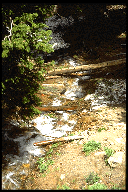Brush: brush-weed-grass mix with brush the major element.
- Poor: less than 50% ground cover
- Fair: 50-75% ground cover
- Good: greater than 75% ground cover
DesertShrub: Saltbush, greasewood, creosotebush, blackbrush, bursage,
palo, verde, mesquite, and cactus.
Farmsteads: buildings, lanes, driveways, and surrounding lots. The poor,
fair,and good buttons have no effect on these values.
Herbaceous: mix of grass, weeds, and low-growing brush, with brush being
the minor element.
Meadow: Continuous grass, not used for grazing, but can be mowed
(usu. for hay). The poor, fair,and good buttons have no effect on this value.
OakAspen: Oak-aspen represents a mountain brush mix, with oak brush, aspen,
mountain mahogany, bitter brush, and maple all included.
OpenUrbanSpace: This represents such things as lawns, parks, golf courses,
or cemetaries.
The value of poor, fair, and good reflects how much grass cover there is in the
area. If grass cover is:
- Less than 50% -- Poor
- from 50%-70% -- Fair
- Greater than 70%-- Good
ParkingLots: Representative of areas impervious to water, such as paved
parking areas, roofs, driveways, etc. The poor, fair,and good buttons
have no effect on these values.
Pasture: Pasture, grassland, or range. Has continuous forage for grazing
The poor, fair,and good buttons represent:
- Poor: less than 50% ground cover or unmulched and heavily grazed land
- Fair: 50-75% ground cover and not heavily grazed
- Good: greater than 75% ground cover and lightly grazed
PavedStreetWithCurb: Paved streets with curbs and storm sewers.The poor,
fair,and good buttons have no effect on these values.
PavedStreetWithOpenDitch: Paved streets with open ditches next to the
road for drainage (as opposed to storm sewers). The poor, fair,and good
buttons have no effect on these values.
PinyonJuniper: Encompasses pinyon, juniper, or both, with a grass understory.
Residential: Residential districts, defined by average lot size:
Use the:
- Poor button for lots of 1/4 acre (represents about 38% impervious coverage)
- Fair button for lots of 1/2 acre (about 25% impervious coverage)
- Good button for lots of 2 acres (about 12 % impervious coverage)
Sagebrush: Sagebrush with grass understory.
Woods: - Poor: Forest litter, smal trees, and brush destroyed
by heavy grazing or regular burning.
- Fair: Woods are grazed but not burned, and some forest
litter covers soil.
- Good: Woods protected from grazing, and forest litter
and brush cover the soil.
WoodsWithGrass: This fits the profile of orchards or tree farms. Represents
approximately 50% woods and 50% grass (pasture) cover. For varying percentages,
use the corresponding pasture or woods value.
|

